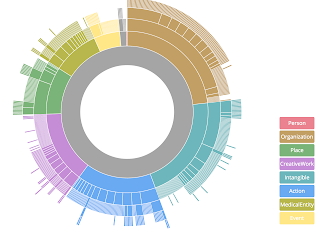 |
| [starburst visualization of schema.org's hierarchy] |
We have just published version 2.2. As usual this combines many small fixes with a mix of new vocabulary, as well as efforts to improve the integration and documentation of our existing vocabulary. And as always you can read the full details in our releases page, which in turn links to our issue tracker for even more details. Here are some highlights:
- We made a number of improvements relating to the description of services, including the addition of providerMobility to indicate dynamic locations, OfferCatalog for hierarchical collections of offers, as well as introduced the notion of a GeoCircle to make it possible to describe service availability in terms of distance from a point or postcode.
- A new type: ExhibitionEvent for describing exhibitions (e.g. in museums, galleries), alongside a property workFeatured that indicates a CreativeWork featured in an Event. This is quite a typical schema.org change: it generalizes existing vocabulary - workPerformed, workPresented - to cover more scenarios with less terminology.
- Added an inverse of the makesOffer property: offeredBy to simplify the description of not-for-profit offers (e.g. library book lending).
- Improved our support for feed-oriented structured data, by adding DataFeed and DataFeedItem.
- Introduced a new type to represent barcodes.
These are just a small sample of the vocabulary changes introduced in v2.2. This release also includes non-vocabulary improvements, such as a simpler feedback form (available from every page in the 'more...' section), some updates to the FAQ on documentation re-use and https. We are aware that the technical nature of our issue tracking site on Github is not ideal for some people, and hope that the improved feedback form will make it easier for the project to listen to a broader audience.
Finally, the illustration above is included here as a reminder that there is more to schema.org collaboration than fixing bugs and adding new vocabulary. The interactive version applies the D3 visualization toolkit to exploring the schema.org hierarchy. Thanks to Fabio Valsecchi (who made this starburst demo), Gregg Kellogg and Sandro Hawke for their investigations in this area. We are collecting visualization ideas and links in our issue tracker. Another area we also encourage collaboration is around finding even simpler ways of sharing schema.org structured data. In particular we would like to draw attention to the CSV on the Web work at W3C, which offers new ways of mapping between tabular datasets and schema.org-style descriptions. To join our discussions on vocabularies, visualization, syntax issues and more, you can join the schema.org community group at W3C.